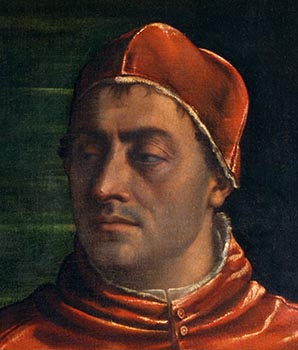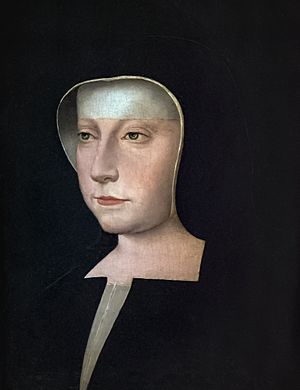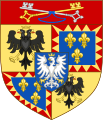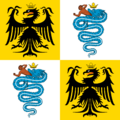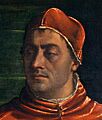War of the League of Cognac facts for kids
Quick facts for kids War of the League of Cognac |
|||||||
|---|---|---|---|---|---|---|---|
| Part of the Italian Wars | |||||||
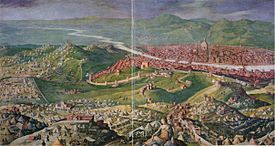 Siege of Florence, 1530, fought during the War of the League of Cognac |
|||||||
|
|||||||
| Belligerents | |||||||
|
|
||||||
| Commanders and leaders | |||||||
The War of the League of Cognac was a big conflict in Italy from 1526 to 1530. It was fought between the powerful Charles V and an alliance called the League of Cognac.
Charles V ruled the Holy Roman Empire and Spain. The League of Cognac included France, Pope Clement VII, the Republic of Venice, England, the Duchy of Milan, and the Republic of Florence. This war was a major part of the Italian Wars, a series of conflicts over control of Italy.
Contents
How the War Started
After France lost a major war in 1521, Pope Clement VII and the Republic of Venice became worried. They wanted to push Charles V out of Italy.
Francis I, the King of France, had been captured. He was released after signing a treaty. Once free, he quickly agreed to help the Pope.
So, on May 22, 1526, a new alliance was formed. It was called the League of Cognac. Francis I, Pope Clement, Venice, Florence, and the Sforza family from Milan joined. They all wanted to break free from Charles V's control. Henry VIII of England was asked to join but refused.
Early Battles
The League quickly captured the city of Lodi. But Charles V's troops soon arrived in Lombardy. They forced the Sforza family to give up Milan.
Meanwhile, a powerful Roman family, the Colonna, attacked Rome. They defeated the Pope's forces and took control of the city in September 1526. However, they were soon paid to leave.
The Sack of Rome
Charles V gathered a huge army. It included 14,000 German soldiers called landsknechts. There were also 6,000 Spanish soldiers known as tercios.
These forces were led by Georg Frundsberg and Charles of Bourbon. They marched towards Rome. The Pope's army, led by Francesco Guicciardini, could not stop them.
During the attack, the Duke of Bourbon was killed. His soldiers, who had not been paid well, then brutally attacked and robbed the city. This event is known as the Sack of Rome.
The Pope had to hide in Castel Sant'Angelo. He managed to escape thanks to the brave Swiss Guards. They fought to protect him.
The Siege of Naples
The terrible attack on Rome shocked everyone. It also meant the Pope could no longer play a big role in the war. This made the French act quickly.
On April 30, 1527, England's King Henry VIII and France's King Francis signed a new agreement. It was called the Treaty of Westminster. They promised to combine their armies against Charles V.
Francis sent an army to Naples in Italy. It was led by Odet de Foix and Pedro Navarro, Count of Oliveto. They went through Genoa, where Andrea Doria joined the French. Doria helped them capture many Genoese ships. The French army then began a long siege of Naples.
The Fall of Genoa
However, Andrea Doria soon switched sides. He left the French and joined Charles V. The siege of Naples then fell apart. A terrible plague broke out in the French camp. It killed most of the army, including their leaders Foix and Navarro.
Andrea Doria then attacked Genoa. He broke the blockade of the city. He forced the French to surrender at Savona. Another French army, led by Francis de Bourbon, was badly defeated at the Battle of Landriano. These defeats ended Francis's hopes of controlling Italy.
Peace Treaties and Agreements
After his armies lost, King Francis I wanted peace with Charles V. Talks began in July 1529 in the city of Cambrai. The main negotiators were Francis's mother, Louise of Savoy, and Charles V's aunt, Margaret of Austria. Because two women led the talks, it was called the Paix des Dames, or "Peace of the Ladies."
The final agreement was similar to an earlier treaty. Francis gave up his claims to areas like Artois, Flanders, and Tournai. He also had to pay a huge ransom of two million gold coins to get his sons back. However, he did not have to give up Burgundy. The Treaty of Cambrai was signed on August 3. It took France out of the war. This left Venice, Florence, and the Pope alone against Charles V.
Charles V then met with the Pope in Bologna. The Pope forgave those who had sacked Rome. He also promised to crown Charles V as Holy Roman Emperor. In return, the Pope received the cities of Ravenna and Cervia. The Republic of Venice had to give these cities to Charles V. Venice also lost its lands in Apulia. In exchange, Venice was allowed to keep some areas it had won earlier.
Finally, Francesco Sforza was allowed to return to Milan. Charles V had originally wanted to put Alessandro de' Medici in charge there. But he changed his mind, partly because Venice disagreed. Francesco had to pay 900,000 coins to get his duchy back.
The Fall of Florence
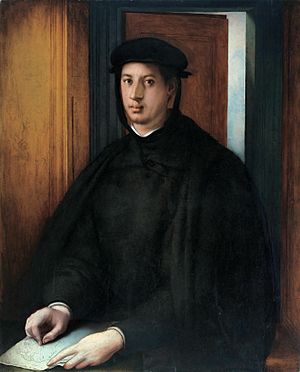
Only the Republic of Florence continued to fight Charles V's forces. These Imperial forces were led by the Prince of Orange. A Florentine army, led by Francesco Ferruccio, fought the Emperor's army at the Battle of Gavinana in 1530.
Even though the Prince of Orange was killed in the battle, the Imperial army won a clear victory. The Republic of Florence surrendered ten days later. Pope Clement VII then made Alessandro de' Medici the Duke of Florence. This ended centuries of republican rule in Florence. From then on, Florence became a hereditary realm ruled by the powerful Medici family.
Images for kids
See also
 In Spanish: Guerra de la Liga de Cognac para niños
In Spanish: Guerra de la Liga de Cognac para niños


